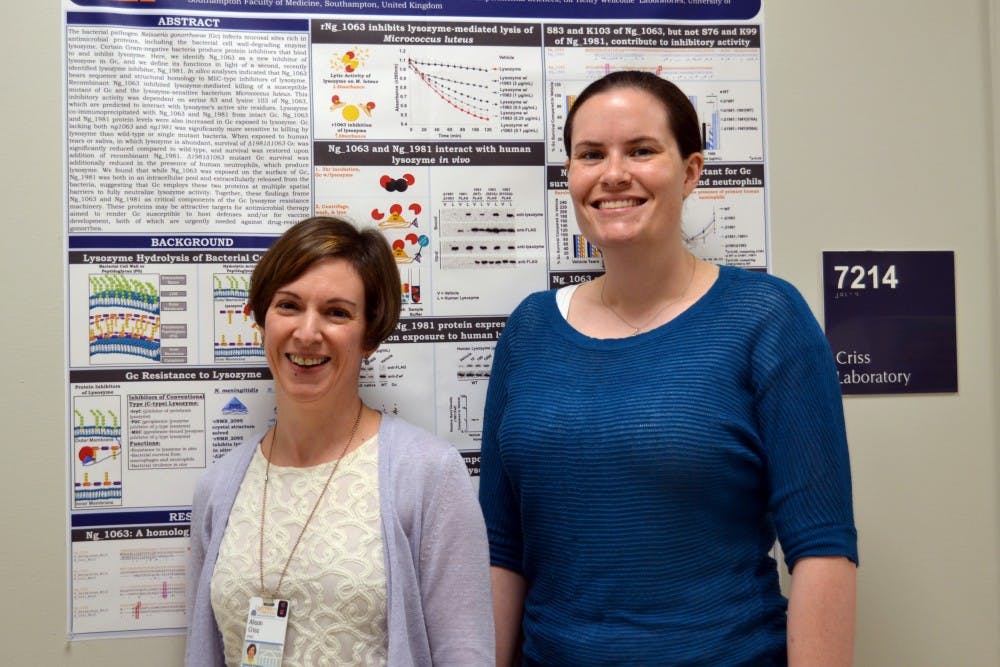In the Department of Microbiology, Immunology, and Cancer Biology, Assoc. Prof. Alison Criss’s laboratory studies Neisseria gonorrhoeae, a bacterium that can lead to the sexually transmitted infection gonorrhea. Criss and Biomedical Sciences graduate student Stephanie Ragland, along with two collaborators from the U.K., found that two of N. gonorrhoeae’s proteins allow the bacteria to resist a human anti-microbial enzyme, opening the way for new therapies to treat drug-resistant gonorrhea infection.
“Neisseria gonorrhoeae is the second most commonly reported bacterial sexually transmitted infection in the United States, Ragland said. “It causes over 800,000 cases each year in the United States alone, and over 78 million cases worldwide.”
While Criss’ laboratory does not have specific statistics about the rates of gonorrhea in Charlottesville, Criss says that the caseload in this area is low compared to other cities such as Richmond, Washington, D.C. and Baltimore.
According to Criss, gonorrhea can be more common in rural areas where healthcare facilities are often not as accessible. While the rate might be low in Charlottesville, outbreaks can occur easily.
Gonorrhea spreads through sexual contact or childbirth. While it can be cured with antibiotics, an increasing proportion of gonorrhea cases are resistant to antibiotics, making the infection difficult to combat. Of the over 800,000 cases in U.S. in the past year, around 246,000 were resistant to at least one antibiotic. According to Ragland, the lack of treatment options for drug-resistant gonorrhea makes it a global health problem.
N. gonorrhoeae can infect mucosal surfaces, which are rich in anti-microbial proteins. However, the bacterium is able to resist these anti-microbial proteins, one of which is lysozyme, Ragland said. Lysozyme is an enzyme that degrades — or lyses — bacterial cell walls, and is present in saliva, tears and other mucosal surfaces.
“We knew that Neisseria gonorrhoeae is resistant to this antimicrobial lysozyme, [but] we just didn’t know how,” Ragland said.
In their study, the researchers found two inhibitor proteins that were both expressed by N. gonorrhoeae, which allowed the bacteria to survive while in the presence of lysozyme, providing direct resistance to this enzyme.
“We didn’t know that the bacteria actually had this particular type of defense, so it’s really fascinating because this opens up a whole new line of understanding about another facet of how these bacteria manage to thrive inside the human body,” Criss said.
According to Ragland, the existence of not one, but two of these inhibitors indicates that resisting lysozyme is key to the bacteria’s avoidance of the body’s defense systems. Since these inhibitors are located outside the bacterial cell, it gives researchers a potential target when trying to circumvent the bacterial resistance through drugs or a vaccine. In the past, it has been challenging for researchers to develop a vaccine against N. gonorrhoeae because its surface antigens are constantly changing — the lysozyme inhibitors present a new, stable target for therapeutics.
According to Criss, if researchers were able to develop a potential drug that could sensitize the bacteria to lysozyme, then this drug could be given as a possible therapy for treating gonorrhea. This drug would be administered with other drugs to make the bacteria more susceptible to being eliminated by the immune system.
“This [drug] would then allow for better clearance of the infection without leading to developing drug resistance,” Criss said.
Ragland and Criss’s full paper can be found here.







